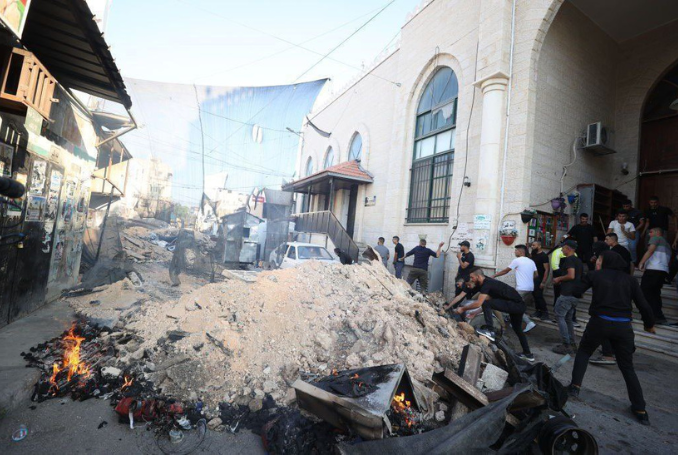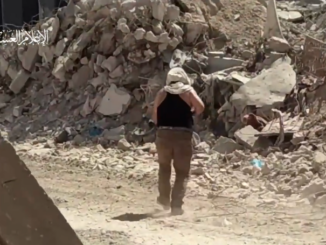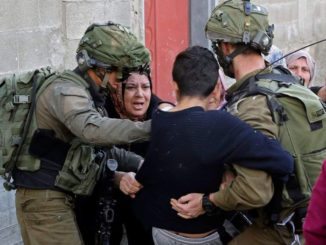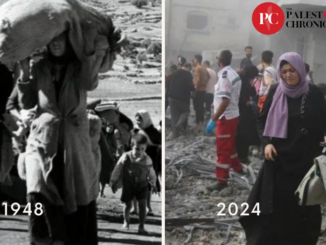
Only after 12 Palestinians were buried in Jenin, and after local and international media entered the camp, the picture of the destruction left in the wake of the Israeli invasion became clearer.
In short, the Jenin refugee camp is almost destroyed, the kind of destruction that can only be compared to the invasion and destruction of Jenin in 2002.
In both cases, the culprit and the victim were the same as of today.
‘Catastrophic’
On Wednesday afternoon, the Jenin governorate warned of the deterioration of the humanitarian situation of thousands of residents because of the Israeli occupation targeting of infrastructure of the city and its camp.
For 38 hours, starting at dawn on Tuesday, July 3, the Israeli military did nothing but destroy, eyewitnesses say. The devastation has surpassed the most pessimistic of expectations.
Thousands of people take part in the funeral of the 12 Palestinians who were killed by Israeli occupation forces during the Israeli military raid into Jenin Camp north of West Bank. pic.twitter.com/1R2ZYxXK4E
— PALESTINE ONLINE ?? (@OnlinePalEng) July 5, 2023
Local authorities in Jenin estimated that about 80 percent of buildings in the camp were completely or partially damaged, Aljazeera Net reported.
The governor of Jenin in the Palestinian Authority, Akram Rajoub, announced on Wednesday the start of an official committee to assess the damage of the Israeli military operation in the camp.
For his part, the deputy governor of Jenin, Kamal Abu Al-Rub, revealed in a preliminary assessment that the camp, which consists of about a thousand properties distributed between houses and apartments, about 80% of them were damaged, and the damage ranged from total and partial destruction – burning, vandalism and damage to property.
The destruction was systematic, according to eyewitness accounts and videos and images that emerged following the Israeli redeployment. Israeli soldiers would move from one house to another, leaving behind nothing but ruins and pulverized concrete.
Jenin Mayor Nidal Abedi described the scale of destruction inside the camp as ‘catastrophic’, noting that the infrastructure in the camp was destroyed.
Why did #Israel invade #Jenin? And did it succeed in achieving its objectives? And why is the #PalestinianResistance claiming victory for the refugee camp over the massive Israeli military machine? These questions and more are answered below .. https://t.co/HrVXPSE13A pic.twitter.com/B9muiOd5p6
— The Palestine Chronicle (@PalestineChron) July 5, 2023
Piles of Iron
Indeed, electricity, drinking water and landlines were cut off and the sewage network was damaged.
Dozens of vehicles were burned, and some turned to a pile of iron on roads where walking has become, at times, impossible.
Many residents who were forced by the Israeli occupation forces to leave their homes and take refuge in hospitals reported that the attacks of the occupation army also pursued them inside hospitals, which they thought would be a haven.
The Latin Parish in #Jenin suffered damage from an ongoing Israeli military operation in the Palestinian city, the Latin Patriarchate of #Jerusalem said on Tuesday.https://t.co/kXbneTHc3V pic.twitter.com/QH6LGkUXRP
— The Palestine Chronicle (@PalestineChron) July 4, 2023
On the other hand, the representative of the World Health Organization in the Palestinian territories told Aljazeera that more than 500 families in Jenin have left or been forced out of their homes, and that the health sector in the city is operating in fragile and ‘exceptional conditions’.
He also stated that during their aggression against the city, Israeli forces had attacked three hospitals, stressing that the financial resources allocated to hospitals were insufficient and that it was important to ensure the necessary equipment in them.
Palestinians returning to their homes in the Jenin refugee camp in the occupied West Bank have been met with scenes of widespread destruction following the Israeli army’s two-day assault. pic.twitter.com/8P7WxeglIC
— Al Jazeera English (@AJEnglish) July 5, 2023
Aside from the 12 Palestinians killed, 120 others were wounded, 20 of whom are in serious condition.
(Palestine Chronicle, Aljazeera)








